This is the recipe for the traditional, baked Chinese Mooncake that is typically eaten during the Mid-Autumn Festival. The mooncake filling consists of a salted egg yolk, surrounded by sweet lotus seed paste, which is wrapped in a thin, tender skin and then pressed into a round or square mold to impart a design onto the skin. The cake is partially baked, brushed with an egg wash, and then finished in the oven.
Last year, I got into making snowskin mooncakes and pandan spiral mooncakes for the Mooncake Festival. (The pandan spiral mooncakes are seriously awesome; I already have orders for more.) However this year, I decided that I had to try my hands with the traditional baked mooncakes. After making three batches of these mooncakes recently, I can say that they’re pretty simple to make, and they come out as good as or even better than store-bought.
Not Hard At All
Now, I’ve always thought that making traditional baked mooncakes were difficult. At least it seemed that way when people talked about how you had to get the skin right or it would not taste good. So I just never thought I’d be able to do it.
With Mooncake Festival just around the corner, I’ve made three batches of these mooncakes so far. I must say I’ve learned a lot about baking them. Are they really that difficult?
Honestly, if you live in Asia where the filling ingredients are easy to find and buy pre-made, and most of the other ingredients for the skin are also prepared for you, it’s not really hard at all. If you live in the West, where the ingredients may be more difficult to find and you’d have to make everything from scratch by yourself, then yes, I’d say it would be tougher.
So while I’m here in Malaysia, I’m taking full advantage of the fact that I don’t have to stir up my own batches of lotus paste filling. I can just drive to the nearest bakery supply store and buy myself some (they even come in low sugar varieties which is perfect for me!).
Baked Moon Cakes Recipe
Prep time: 1 hour / Cook time: 30 minutes
Ingredients for the skin
240 grams mooncake golden syrup
75 grams cooking oil
1/2 tsp baking soda
1/2 Tbsp alkaline water
300 grams superfine flour
Method
- Combine golden syrup, cooking oil, baking soda and alkaline water in a bowl and mix well.
- Slowly add the superfine flour to the liquid, using your hand to mix the ingredients well. The dough will be sticky like taffy.
- Wrap the dough in plastic wrap and set aside for at least 3 hours and up to 3 days.
Making Traditional Mooncake Skin Dough
- If you’re planning to use salted egg yolks in your filling, you need to separate the yolks from the whites, then steam the yolks for 10 minutes over medium-low heat. Let the yolks cool before using.
Steaming Salted Egg Yolks
- Enclose the egg yolk in lotus seed paste filling (how much? It depends! See Tip #2 below). Take some of the dough for the skin and form a disc, then gently but firmly push the skin dough around the filling. Check often to see if there are any breaks in the dough.
Wrapping Traditional Mooncakes
- Preheat the oven to 200 degrees C.
- Press the ball of dough and filling with the mooncake mold to impart the design. Set the molded cake on a greased tray.
Pressing Traditional Mooncakes
- Bake for 10 minutes, then remove from the oven to cool for 10 minutes.
- Lightly brush the top and sides of the cake with an egg yolk wash.
Brushing Traditional Mooncake with Egg Wash
- Return the tray to the oven and bake for another 8 minutes at 200 degrees C.
- Remove cakes from the oven and cool.
Traditional Baked Mooncakes
Important Mooncake-Making Tips
Most recipes you find on making mooncakes will only give you a list of ingredients and then provide simple instructions. Not so easy if you’re a newbie to making them and need more detailed instructions.
So here are some tips for mooncake making that I’ve picked up by talking to the bakery supply shop owner (who teaches a mooncake-making class) while buying ingredients, through reading recipes online and from mooncake cookbooks (yes, I actually bought a cookbook talking specifically about mooncakes) and by experimenting as I made my own:
Tip #1: Patience
Making traditional mooncakes is all about waiting.
After you’ve assembled all your ingredients and mixed it up, you have to wait. The shop owner told me to wait for three hours, which I did for the first batch. The cakes turned out alright but I decided to save half the dough to make more the next day and THOSE mooncakes turned out even better.
I guess you need to give the dough time to develop and smooth out. When you first mix the dough together, it has an almost taffy like texture–very sticky and wet. But after a long wait, the dough is smooth and tacky. Very much like soft Play-Doh and very nice to work with when you’re trying to stretch that skin as thin as possible to wrap around a large amount of filling.
Also, after baking the mooncakes, you should not eat them right away. Give your cakes a day before cutting into them. The skin will soften up a little bit more giving it the right texture and chew.
So, a long wait time before using the dough and a long wait time after baking the cakes and your mooncakes will be beautiful and tasty.
Tip #2: Precision
As with most baking recipes, you need to have a weighing scale when making mooncakes. The general rule of thumb on baked mooncakes is a ratio of one part skin dough to three parts filling. For example, if your mooncake mold can hold 120g of mooncake, then divide that number by four, thus making your skin 30g, and your filling 90g. If you add a salted egg yolk to the filling, then you need to weigh that and subtract that weight from the 90g of filling that you need.
Tip #3: Play
Making mooncakes may take patience and precision but it also has an element of fun. If you are the sort of person who likes to work with your hands, you will enjoy making mooncakes.
When you are mixing the skin dough, it is recommended that you mix with your hand–if you’re squeamish about getting your hands sticky, then this is not for you, but if you don’t mind, mixing with your hand gets the job done very well. I normally don’t like having sticky hands but this time around, I didn’t seem to mind it. I just considered it as extra exercise (the dough gets stiffer as you finish adding the flour slowly).
You also need to knead the dough after the resting period to make it more pliable. As you knead it, the color of the dough becomes more white and when you stretch it out, it will be more smooth and be less likely to break.
Another part of play happens when thinking about the filling. To date, I’ve bought white lotus paste, pandan lotus paste, durian pandan paste, and red bean paste. Initially I was using one paste for one mooncake but then I decided to try mixing them around. So recently, I wrapped one paste with another (keeping in mind the total weight) to see if I could get a different taste and visual effect. So far, I’ve mixed pandan with white lotus (the green color against the orange yolk is beautiful), and red bean with white lotus. I’ve been having fun!
The final part of play is the challenge of stretching that skin evenly to wrap around the filling. If you’ve kneaded it well, the dough will be pliable enough to stretch slowly into a thin skin for the filling. Don’t worry about perfect thickness too much as I usually find one part that is slightly thicker (the thinner part will have the filling shining through). This is not a bad thing as I use this thicker part for the part of the cake that receives the design. As you press the dough into the mold, the mold creates a beautiful design in the thicker skin.
Go For It
So there you have it, the traditional baked mooncake recipe. I hope you get to try it out for yourself. It really is easy once you get the hang of it, and it’s fun to do. Enjoy!
Cheers, Annie
If you like this recipe, please share it with your friends on Facebook, Twitter and other social networking sites!

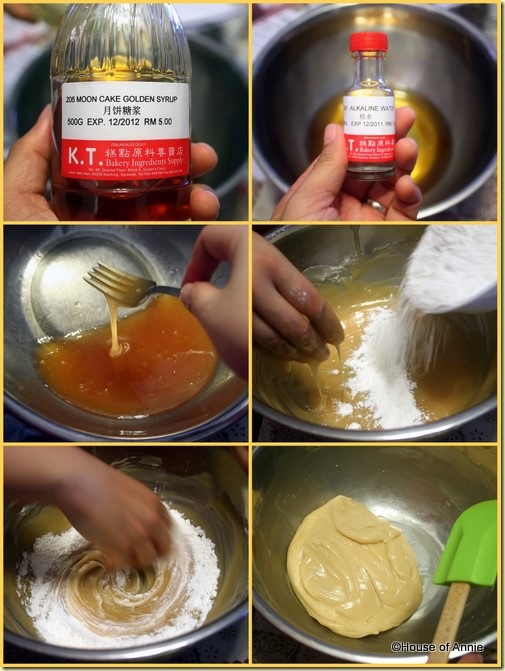
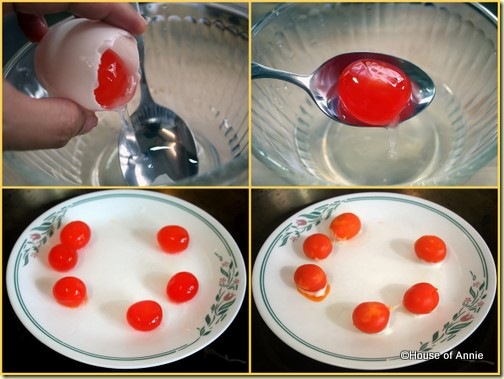
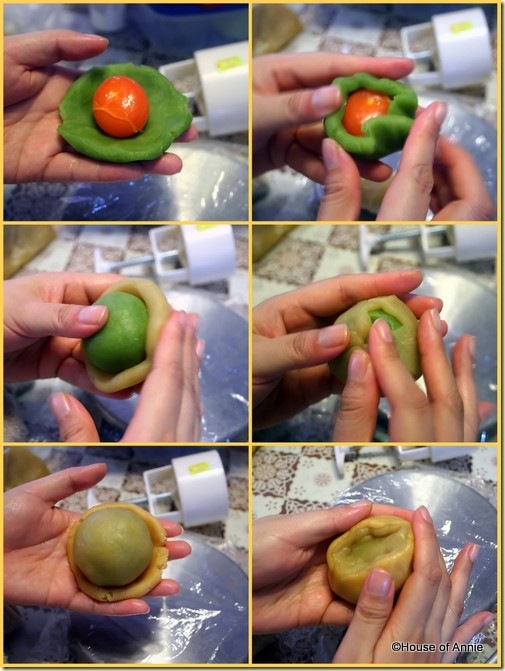
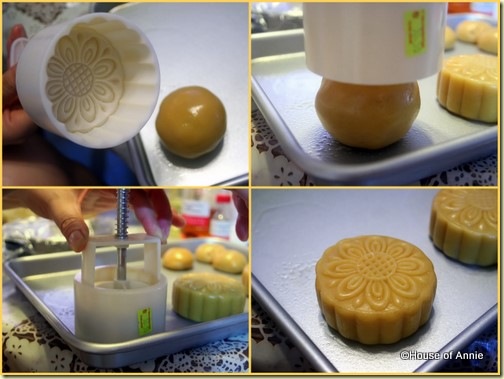

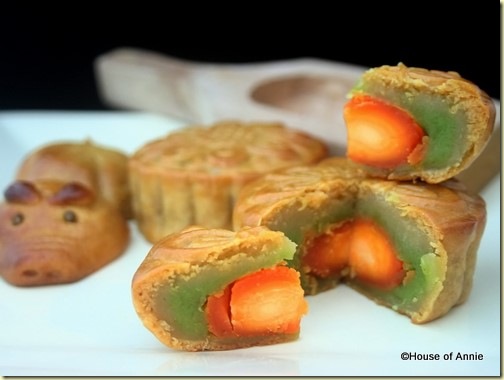
wow and wow…I have mooncakes every year but never thought about making them at home.
Thanks for sharing this wonderful recipe!! The recipe makes it so doable at home. The only thing I am wondering is where do you get one of those mooncake molded?
Yi,
thanks for the comment, and welcome!
You should be able to find the molds in Chinatown. Try the baking supply sections in the Asian grocery stores.
I ate my first mooncake at the Mid-Autumn Festival in San Francisco last year. So tasty! I’d love to try to make them myself. Thanks for sharing!
Baltic Maid,
welcome, and thanks for the comment!
Any well-stocked Asian grocery store should have the ingredients you need. The one thing that might be hard to find is the lotus seed paste. But you can also use azuki (red bean) paste and that can be easily found in Japanese grocery stores.
Good luck, and happy cooking!
Thanks! I’ll try to find the ingredients, especially the lotus seed paste or azuki. I’ll see what I can find. I am really excited to try this! Thanks again!
The colors are incredible! The newer molds sure do look easier. I remember when a chef at Ming’s in Palo Alto showed me how to make a mooncake in the traditional wooden mold. It took some doing to “whack” it out and onto the table. 😉
Carolyn
Yes, these plastic molds make things so much easier – no whacking required 🙂
Have you seen these molds over in the US?
Where can you buy the new plastic molds?
Do you have a store’s name and address?
Thanks.
DD –
we live in Kuching, Sarawak, Malaysia now. I can tell you where we bought them here, but that wouldn’t do you any good there in California.
I’ll see if we can locate a source in the Bay Area, or if you can purchase them online.
You make it look so easy! And your salted egg yolks are gorgeous – did you salt them yourself? Wondering about the cute pig in one of your pictures. Is that with leftover dough?
Christine
No, we didn’t salt the eggs ourselves. Maybe next year 😉
And you noticed the pig! Yes, we had a little leftover dough so we made some pigs with it. We’ll post the how-to for the piggy mooncakes soon.
I bought my first mooncake mold on eBay, and now I’m looking for recipes. I love how clear and detailed your instructions are! Thank you so much for explaining the process so well.
I do have a couple of questions though.
What is mooncake golden syrup? Can I use regular golden syrup?
Why alkaline water and not tapwater? I looked it up on the internet, but I didn’t find what difference it makes in a pastry dough.
Anna–I’m not sure if there is a difference between regular golden syrup and mooncake golden syrup. I suspect there is no difference–when I’ve looked at recipes that make their own mooncake golden syrup, it’s a mix of sugar, water, and lemon.
As for alkaline water, the Chinese word for it is Kan Sui and it is also sometimes called lye water. Most times, it is used here to influence the texture of foods. Most noodles in Malaysia utilize alkaline water to make the noodles chewier. I suspect it plays a similar role here in the mooncake skin–to help with the texture of it.
Hope that helps. Let me know how your mooncakes turn out.
I love the color combination of the green paste and the burnt orange yolk. Is the lotus seed paste always so green? Why is it that we never see anything like this in the States? They really need to import some moon cakes from Malaysia.
Ben –
the green paste is pandan-lotus, not just straight lotus. I don’t recall seeing the pre-made lotus paste for sale back in the States. Maybe we’ll do a post on how to make the paste…next year.
Thanks for reaching out on Twitter..found this lovely space. And all your recipes are quite new and exciting.
Sanjeeta,
welcome to our blog! (Thanks for the Twitter follow, too.)
Oh, the photos are great! They make me hungry! LOL Good thing you have photos for the steps, too. I’m visual so it really helps me follow your instructions. I think I have to work out more on being patient if I want to actually try and cook homemade mooncakes. I really love your blog!
Sheila,
welcome, and thanks for the nice comment.
Making mooncakes does take patience, but the more you do it, the easier it gets.
Even though I know I will never have the courage to try and make these, I found the process fascinating. GREG
Greg,
I’m sure you do not lack courage! 🙂
So kind of you to share those tips. Will certainly bear this mind when I try my hands at making these traditional ones. I’ve made your spiral mooncakes and will be posting this on my blog later in the week.
Cheah,
you’re welcome.
Let us know when your post is up!
Hi,
I´m from Indonesia but have been living in Spain for 20 years. Some months ago i was looking for moon cake recipe and found your blog. I tried to make spiral moon cake with chestnut paste(i made it from scratch). Although the skin didn´t turn out like yours (may be because when i rolled it i pressed too strong) and the filling is too dry but they were yummy.
I´m now preparing to make chestnut paste again. This time i´ll try to make the traditional ones. I have alkaline powder do you know how to prepare it and the propotion ?
I like your blog and your generosity to share your recipes with others. By the way i have small wooden mould, 4 1/2cm x
4 1/2cm(depth 2cm), what is the ratio of skin and filling?
Bertha,
Welcome! Thanks for the comment and questions.
According to this website http://www.guangyi.net/en/ProductShow38.htm
The ratio of alkaline powder to water to make the mooncake solution is 0.4%. I guess that would be 0.4 grams per 100 ml of water?
As far as the skin:filling ratio, we suggest you pack the mold with some dough first and then weigh the dough. Divide the dough’s weight by four and you will have the amount of dough you need for the skin, with the rest being filling.
If you have further questions, feel free to leave a comment.
Good luck!
Hi, Nate
Thank you sooooo much for sharing the recipe and i love your blog.
I am trying out the mooncake today, hope it turn out well. few questions to ask you before i screw up my moon cake, this is my first attempt. :>
1) after u prepare the dough n wrap it with cling, do u leave it at room temperature till next day or in fridge?
2) from your recipe, how many medium mooncake can i bake?
3) When do the egg wash, do i use lightly beaten egg york? without adding any water or milk?
Thanks again.
Hi Janet,
1. You leave it at room temperature.
2. I could bake about 15-18 mooncakes (sometimes I made a dozen and used the rest to make pigs)
3. It is just egg yolk without any water or milk.
Hope that helps.
Wow, your baked mooncake recipe is so detail and Thanks for sharing the detail steps pictures. I noticed i did not add baking soda, do you think add soda will give softer crust?
Sonia,
Thanks for your comment!
Yes, baking soda will make a softer crust; the downside is that you won’t get as sharp a design in the skin from the mold. but I think the main problem with your crust cracking was that you didn’t wait for the cake to cool before brushing on the egg wash.
Happy cooking!
I think the crack is due to high heat baking. Try shorten the baking process on first round, looking at the piggy, i think the oven temperature is slightly too high. Try to avoid baking soda, the listed ingredient minus the soda is good enough to make the mooncakes soft after a few days.
I prefer wood mould to plastic plunger, wood mould give better shape and sharper design.
Dear Jennifer,
Thank you for your suggestions. I agree that a wooden mould gives nicer designs but since my moulds are at my mom’s place and I didn’t have any with me, I used the plastic ones (and they turned out fine). Also, if I had gotten new ones, I would have had to season them well before using and I didn’t have time for that.
As for baking soda, I think it’s up to the individual. When I asked my baking supply store why the baking soda, he said you could leave it out but the baking soda helped the skin to have a nicer texture and I found that it did. Perhaps your skin dough did get softer after a few days but my family couldn’t wait that long to dig in. ^_^
I would like to try it, although it doesn’t look like as easy as a piece of cake. Could you tell me where I can get that fancy moon cake mold? I hate not to do the things the way it should be. And thank you for sharing. By the way, do you happen to know how to make pieapple filled moon cake? I have been looking for the recipe for a long time.
Dear Mei-yu,
I got my mooncake molds at the baking supply store here in Kuching.
Unfortunately, I don’t have the recipe for the pineapple filled moon cake. What I do have is a recipe for a closed pineapple tart which is very similar (to me, better) than the Taiwanese pineapple cakes (if this is what I think you’re referring to). Do try it out and let me know what you think.
https://www.houseofannie.com/homemade-pineapple-tarts-part-2/
Hi. Tried yr recipe twice and have problem with the dough. Eventhough I left it overnight, the dough was still very sticky and stucked in the mould. Eventually the mooncakes were melting before baking and after baking, they were badly disfigured.
Dear Angel,
I’m sorry to hear that you had issues with the dough. I must say that since I didn’t use a wood mould, I am not sure how to problem solve for you. Here are some suggestions based on my conversations with my bakery supply store owner:
1. When using wooden moulds, you have to season your mould before using. He says it is better to soak your mould in oil for a few days. Perhaps your mould is too new?
2. You should also dust the mould with flour before putting in the dough. That will help in easing the cakes out.
As for the stickiness of the dough, I really didn’t have this problem at all. Did you measure all your ingredients carefully? The dough I got was nice and firm after resting.
I hope this helps and I’m so sorry it didn’t work out better. I’ve made this recipe 4 times this season with no issues whatsoever. I wish you better success in your future attempts.
Hi!
Thanks for the wonderful tips and and the recipe for mooncakes!
My family totally love the piglets and prefer piglets to the mooncakes actually! I was just using a regular cookie cutter instead and was contemplating buying the mould until I saw your recommendation on how to shape piglets!
Thanks for the tip! I’ll post when I’ve done them!
Wow. Way to go! And welcome back to Malaysia! I think the last time I made my own moon cakes was several years ago…then i became lazy…:) but I am going try making them again this time around, all because of the ridiculous prices it’s being sold here…I find it’s more worth it to make my own…its the waiting part that I don’t really like…my method is a bit different, I mix the ingredients and let it rest 3 hrs, then I knead it & let it rest another 8 hrs, then only I bake it. Maybe I’ll try your method. By the way, if u like a darker golden color to your moon cakes, just add a drop or two of dark soya sauce to the mixture before kneading. It won’t spoil the taste.
Dark soy sauce for a darker colour–awesome tip! I’ve always believed that soy sauce is the answer for everything ^_^. Thank you so much for that and also for your comment on your method. I may have to try yours the next time to see if there is a difference.
I also agree about the prices. That was what compelled me to start but now that I have, I also understand the need to charge so much–the ingredients are really expensive!
Ok, I have tried making mooncakes for many years, living overseas and having to make my ingredients from scratch. I am definately going to try the baking part of your recipe as I could never get the design to stay after baking.
Alkaline water is actually made from using baking soda aka Bicarbonate of soda (1 tsp) to 1 cup of distilled water.
Biggest question – shouldn’t the liquid measure be in ‘ml’ instead of ‘gm’? This has been my biggest hurdle when I use the recipes that I’ve found.
Margaret,
welcome, and thanks for the question!
The reason we’re measuring the oil in grams instead of millilitres is that we’re using a digital scale to weigh out all the ingredients. Once one ingredient goes in the bowl, we tare the scale and add the second ingredient.
One side benefit to this is, of course, no measuring cups to wash! 🙂
Hope this helps. Good luck with your mooncakes!
Cheers, Nate
Ok, I do a lot of baking so will do the conversion myself.
I find it easier to use measuring cups for the liquids. Got only 2 days prep work to get the mooncakes ready for my daughter to bring to class to share with her friends this tradition.
I never see the pressing mold for a mooncake before. So cute!
hi,
I try out ur recipe this morning. NI fact i prepared the dough last night and only baking it this morning. Well the dough gives very good printing.. but my bottom mooncake is burnt. Can u enlighten me why ?
Thanks
Simonne
what kind of oven are you using?
Nate
Mine is electric oven. Anyway I try again last night. Baking them at 180 C 15 min + 5 min
This time is better 😀 ^__^ I even posted some of the mooncake pic on my blog. Thanks for sharing the recipe
Hey guys, thanks for posting this! I’ve been trying to find a good moon cake recipe for a while now. Just a few questions about the ingredients. Instead of using moon cake golden syrup, can i just use corn syrup? Also, what exactly is alkaline water? Is it absolutely necessary for this recipe or can i just omit it?
Viviano
I really can’t say what will happen if you use corn syrup vs golden syrup.
You can leave out the alkaline water but it will make your dough more hard and brittle.
Hi…
Why do my moon cakes shape/flower faded after i brush the egg wash?
Melissa,
welcome, and thanks for your question.
The mooncake dough is soft, even after the first baking / resting period. You have to *lightly* brush the egg wash on. Even then, the sharper edges of the skin will get smoothed down.
Cheers!
I have tried to make the mooncake but the dough and design completely melts during the baking process. Could you tell me why? Could it be the my oven is a convection oven and the temperature is too high?